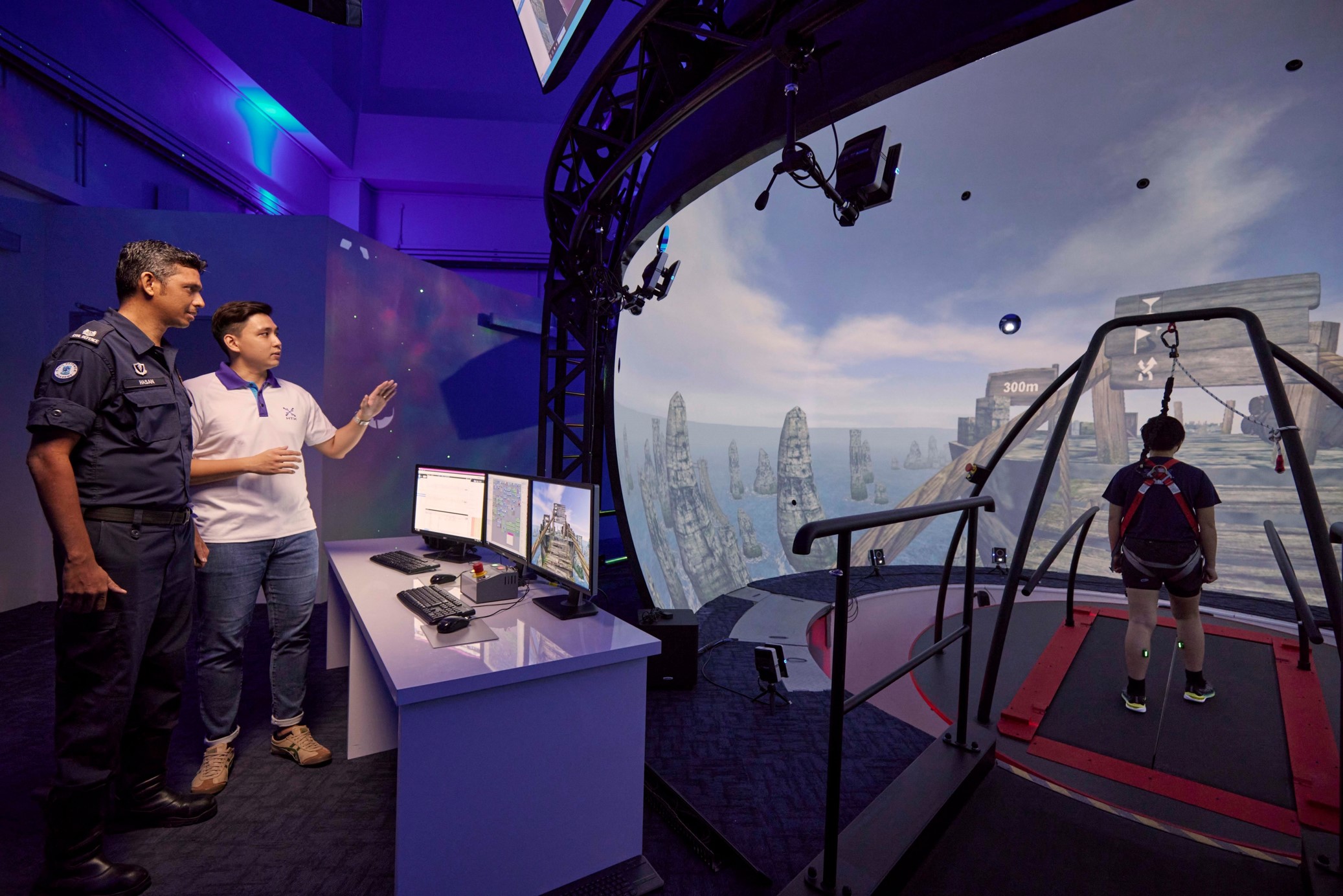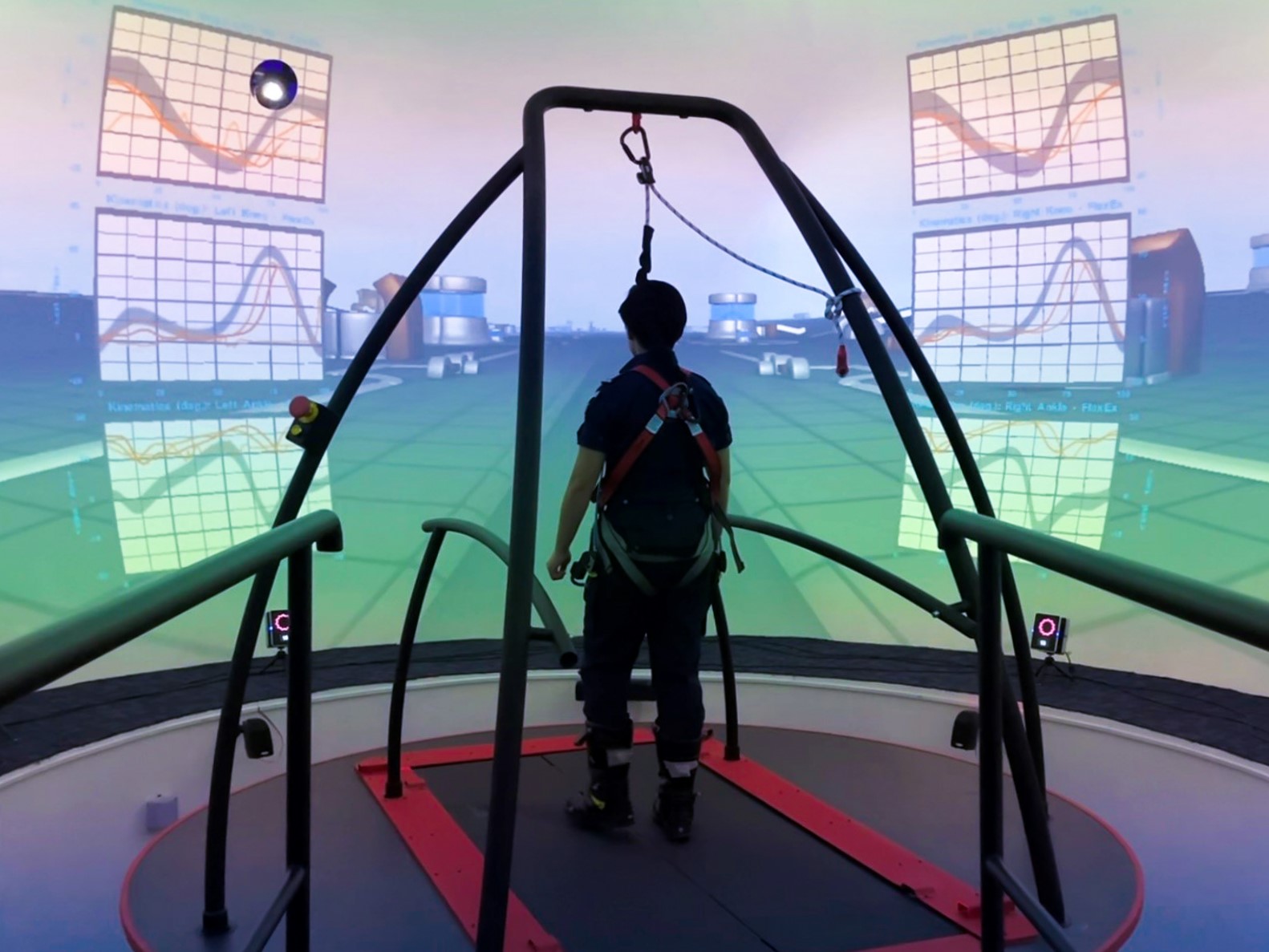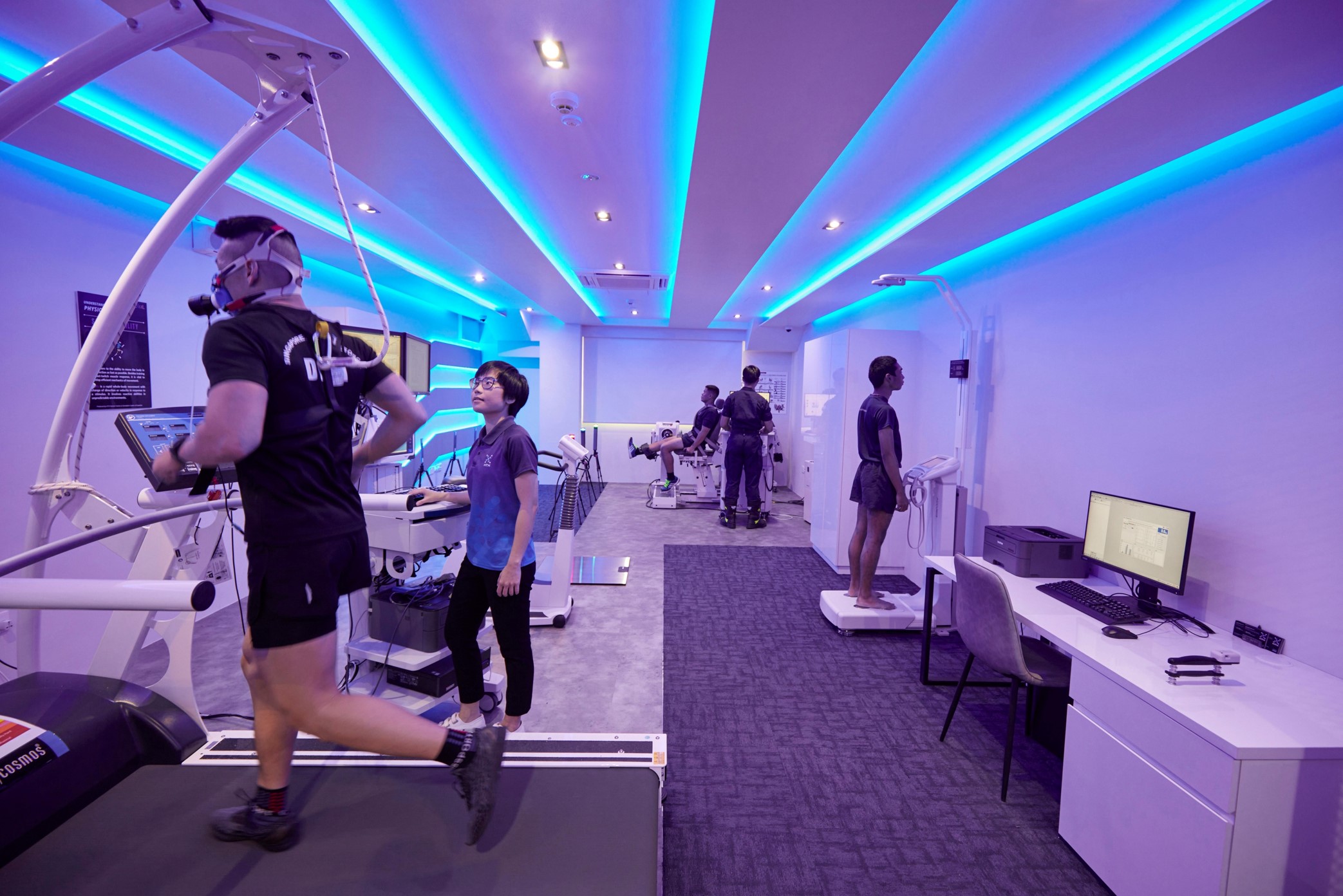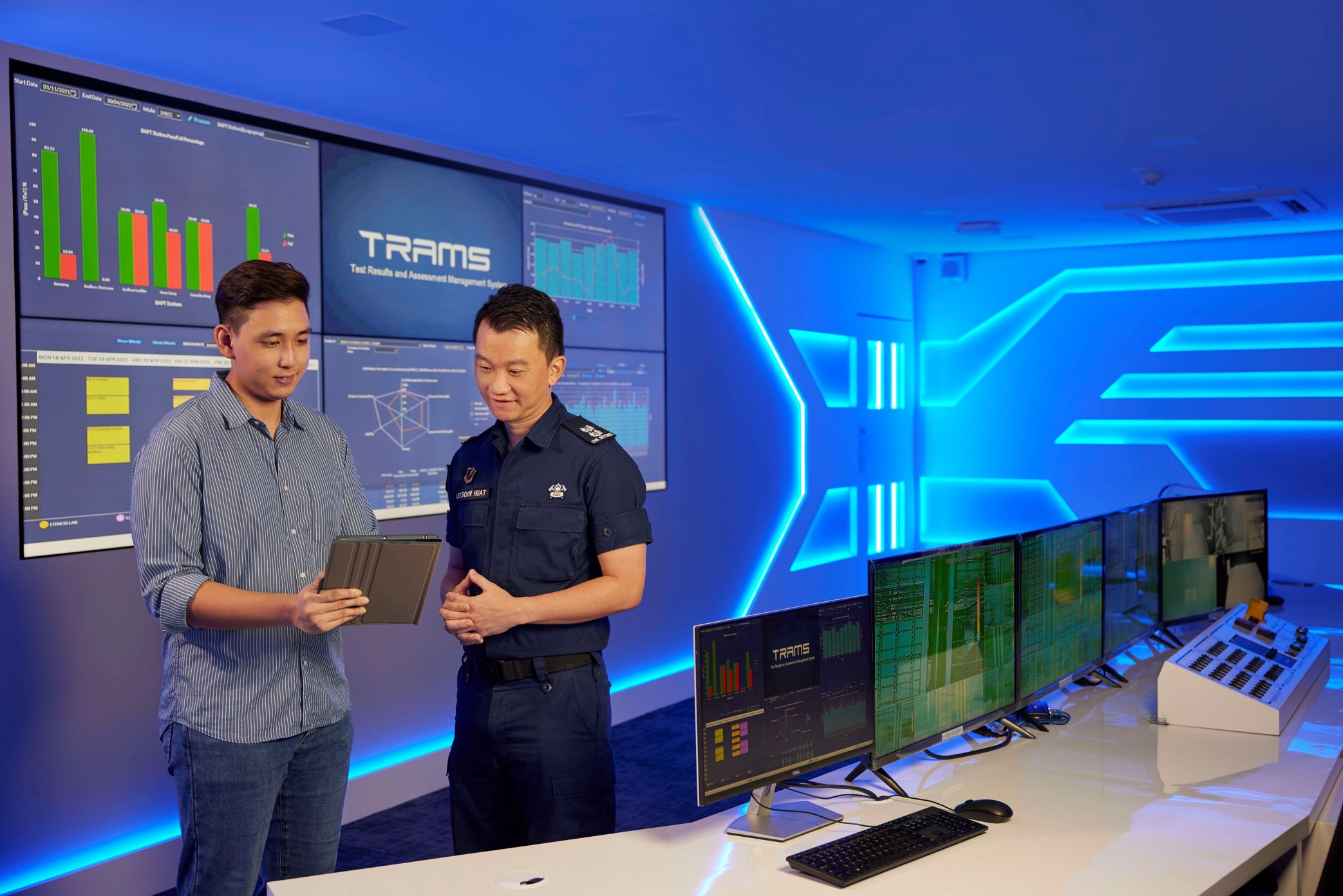
(From left to right) LTC Hasan Kuddoos, Principal Responder Resilience & Systems Officer at SCDF, and Lowell Chong, Scientist, Human Performance, Interaction & Teaming at HTX, discussing an officer’s movement efficiency at the Strength, Conditioning & Rehabilitation in Virtual Environment (STRiVE) (Photo: HTX)
The new Emergency Responders’ Fitness Conditioning and Enhancement Lab (EXCEL) at the Civil Defence Academy was officially launched today.
Jointly developed by HTX and the Singapore Civil Defence Force (SCDF), EXCEL is a purpose-built research & development (R&D) and training facility that will enhance and redefine the capabilities of emergency responders across the Home Team.
“EXCEL will form the core of SCDF-HTX research, development and education, and provide a comprehensive and scientific approach to training and operations,” said Ying Meng Fai, Director of Human Factors & Simulation Centre of Expertise at HTX.
“It will enable us to further our research on emergency responder performance to develop new training paradigms that challenge existing norms and further push limits of human performance to enhance the operational readiness of our Home Team officers,” he said.
EXCEL at one glance
|
Size |
Built-up area of over 1,200 sqm |
|
No. of labs (5)
|
- Strength, Conditioning & Rehabilitation in Virtual Environment (STRiVE) - Heat Acclimatisation and Thermoregulation (HEAT) Lab - Fitness Evaluation Lab - Cognitive Lab - Digital Learning Lab |
| Nerve centre | System Control & Data Analytics Centre |
Here’s EXCEL in photos:
Strength, Conditioning & Rehabilitation in Virtual Environment (STRiVE)

STRiVE combines a motion platform with six degrees of freedom, an instrumented dual-belt treadmill, a motion capture system and a visualisation and audio system to provide responders with real-time feedback on kinetics and kinematics. (Photo: HTX)
The Strength, Conditioning & Rehabilitation in Virtual Environment (STRiVE) is an advanced biomechanics lab with a 360-degrees interactive virtual environment for the assessment of human factors and ergonomics. It can also be used for conditioning for operational and unconventional terrains, such as simulating rough waters during motion acclimatisation training for responders in marine units.
Heat Acclimatisation and Thermoregulation (HEAT) Lab

The HEAT Lab prepares responders to operate in challenging and extreme conditions such as cold and heat stress. (Photo: HTX)
The HEAT Lab is set in an environmental chamber that has a temperature range from -10⁰C to 80⁰C and a humidity level between 20% and 95%.
The chamber simulates climatic conditions (e.g. temperature, relative humidity, and wind speed) for SCDF’s Breathing Apparatus Proficiency Test (BAPT). The BAPT assesses the operational fitness of firefighters and comprises six elements – BA donning, ladder climbing, stair climbing, fire hose carry, casualty carry, and the BA maze.
SCDF and HTX scientists will be able to study how environmental factors affect physical performance, and in so doing, enhance SCDF responders’ resilience and the Home Team’s operational capabilities.

An SCDF Section Commander (centre) at the BAPT casualty carry station. (Photo: HTX)
Fitness Evaluation Lab
 The Fitness Evaluation Lab employs gold standard scientific procedures to measure key components of physiological fitness and enables the establishment of benchmarks for elite/specialist vocations as well as individual strengths and weaknesses for targeted interventions. (Photo: HTX)
The Fitness Evaluation Lab employs gold standard scientific procedures to measure key components of physiological fitness and enables the establishment of benchmarks for elite/specialist vocations as well as individual strengths and weaknesses for targeted interventions. (Photo: HTX)
The Fitness Evaluation Lab is equipped to assess:
- cardiorespiratory endurance by measuring maximal oxygen consumption (VO2 max),
- muscular strength using multi-joint and grip dynamometers,
- body composition using a bioelectrical impedance analyser,
- lower-body power through a vertical jump testing system, and
- speed and reactive agility through a dual beam timing system.
Cognitive Lab

The Cognitive Lab enables the research and development of new cognitive training protocols to enhance responders’ cognitive and behavioural performance. (Photo: HTX)
The cognitive lab leverages advanced technologies and classical experimental methods that include:
- a functional near-infrared spectroscopy (fNIRS) system to monitor brain activity for the profiling of mental workload associated with specific tasks,
- an eye tracking system for training and evaluation of visual scan patterns for situational awareness, and
- a Psychomotor Vigilance Test (PVT) to identify attention and fatigue changes throughout different task types or training regimes.
System Control & Data Analytics Centre

The System Control & Data Analytics Centre is the nerve centre of EXCEL. (Photo: HTX)
The data from STRiVE, HEAT Lab, Fitness Evaluation Lab, Cognitive Lab, and Digital Learning Lab come together in the nerve centre of EXCEL – the System Control & Data Analytics Centre – and are centrally managed through the Test Results and Assessment Management System (TRAMS).
EXCEL will also serve as a nexus for HTX’s Human Factors & Simulation Centre of Expertise scientists and SCDF’s Responder Performance Centre officers to collaborate on inhouse R&D projects with the aim of redefining responders’ performance.

